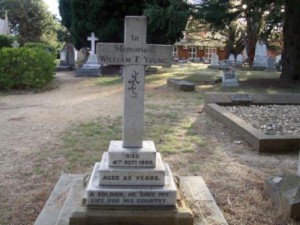Service Details
- Branch of Service
- Army
- Conflict
- South Africa (Boer War) (1899-1902)
Personal Details
- Gender
- Male
- Other Name(s)
- Known as 'Fred'
- Date of Birth
- 29/06/1877
- Place of Birth
- Round Hill, Weetangera
- Address (at enlistment)
- Church Lane, Canberra
- School(s) Attended
- St. John's School (Reid)
- Occupation
- Labourer
- Next of Kin
- Son of William and Bridget (nee Grady) Young, of Canberra
- Burial Place
St John the Baptist Church of England Churchyard, Canberra in grave C.2.132.
Unit and Rank Details
- Service Number
- 230
- Final Rank
- Private (or Trooper)
- Final Unit
- D Squadron, 1st Regiment NSW Mounted Rifles
Fate
Invalided to Australia with enteric fever. Died at St Vincent's Hospital, Sydney on 4 October 1900 aged 23 years.
Commemoration
Boer War Memorial, Lowe St, Queanbeyan NSW
Awards and Honours
Posthumously awarded Queen's Medal with six clasps on 3 April 1906.
Notes
Young was born in Canberra on 29 June 1877 and spent his first few years at a property owned by his parents and grandparents at Round Hill (a property later called 'Glenloch' on the northern side of the National Arboretum). The family was forced to move in 1882 after his father was bankrupted by legal action taken by Frederick Campbell of 'Yarralumla' and so they eventually moved to a farm on the banks of the Molonglo River, the site of which is at the end of Anzac Parade. His father William Young died in 1894, leaving his mother to raise nine children and Fred as the oldest male in the household.
After the war with the Boers in South Africa began in late 1899, Young joined D Squadron of the New South Wales Mounted Infantry, leaving Sydney on 17 January 1900. On 7 March 1900 his unit fought the Boers in the Orange Free State at Poplar Grove and again three days later at Driefontein before entering Bloemfontein a week later. It was his last action in the war as Young was wounded in the hand and invalided to Australia with enteric fever in August 1900. He died at St Vincent's Hospital in Sydney on 4 October 1900 aged 23 years and was buried in St. John's churchyard in Canberra. His grave is maintained by the Office of Australian War Graves. Young was posthumously awarded the Queen's Medal with six clasps in April 1906. He was a cousin of Stan O'Grady, who was killed in action on Gallipoli in 1915, and of Effie Bean, wife of war historian Charles Bean.
Sources
AWM Roll of Honour Database
John Cope, Boer War Men of the Queanbeyan - Braidwood Region: Adventurers or Patriots?, Charnwood, ACT, Ginninderra Press, 2005 (pp. 220-5)
John Cope, 'Pioneer Parson of Early Canberra', 2006
Frank Cranston, 'The soldier that Canberra forgot', The Canberra Times, 9 March 1980
Lyall Gillespie, Canberra 1820-1913, Canberra, AGPS, 1991 (p.266)
Peter Procter, Biographical Register of Canberra and Queanbeyan, Canberra, Heraldry and Genealogy Society of Canberra [HAGSOC], 2001 (p.351)
Don Mountain (ed.), Monumental Inscriptions: Australian Capital Territory including Jervis Bay, Canberra, HAGSOC, 2001 (p.27)
Queanbeyan Observer - 22 December 1899, 5 October 1900, 9 October 1900
Queanbeyan Age - 23 December 1899, 12 September 1900, 19 September 1900
The Canberra Times - 20 March 1980
